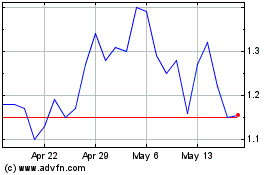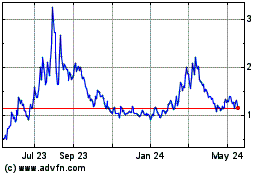Rigetti Introduces Novel Chip Fabrication Process For Scalable, High Performing QPUs
16 August 2024 - 6:05AM

Rigetti Computing, Inc. (Nasdaq: RGTI) (“Rigetti” or the
“Company”), a pioneer in full-stack quantum-classical computing,
today announced that its paper introducing a novel chip fabrication
process, Alternating-Bias Assisted Annealing (ABAA), was recently
published in Nature Communications Materials. ABAA allows for more
precise qubit frequency targeting, enabling improved execution of
2-qubit gates and improvement in performance, which both contribute
to higher fidelity. This technique is now being leveraged to
fabricate chips for Rigetti QPUs, including the Novera™ QPU and the
upcoming Ankaa™-3 system.
The basis of Rigetti’s superconducting qubits are Josephson
Junctions (JJs), which are two thin layers of superconducting metal
(aluminum) separated by a barrier (aluminum oxide). Electrons are
able to tunnel across the insulator from one electrode to another —
resulting in a characteristic frequency for the qubit that allows
for it to be controlled and measured. While the reproducibility and
energy loss in these junctions has been difficult to control, the
simplicity, scalability, and ease of fabrication of these
superconducting devices makes them one of the most desirable
platforms for building quantum computers. Finding a solution to the
junction reproducibility problem has been a long-standing goal in
the field.
Rigetti researchers discovered that by applying a series of low,
alternating voltages at room temperature to the oxide barrier, the
qubit frequencies can be precisely targeted. The ability to
controllably tune qubits prior to a chip being packaged is
essential for large-scale QPU production. This improves the
addressability of the qubits, speeds up interactions, and improves
the scalability of the technology. Unlike more complicated
solutions that address the problem of tuning frequency, which often
require laser trimming of the chip, the ABAA technique is a simple
and scalable process that only requires sending pulses of voltage
to the chip.
“We’ve long known that having our own foundry is a tremendous
asset to our chip design and fabrication processes. Introducing the
ABAA technique is a perfect example of our ability to rapidly test
and implement new methods to improve our capabilities,” says Dr.
Subodh Kulkarni, Rigetti CEO. “We believe this new technique
strengthens our path to scaling to even higher qubit count systems
with greater control over our qubit performance.”
In addition to improving the precision and the accuracy of
Rigetti’s qubits, the ABAA technique has also proven to heal some
of the defects and imperfections in the JJs, allowing for clearer
communication between qubits and couplers — which also leads to
improved performance due to less interference on the circuit.
The Company will leverage the ABAA technique for its anticipated
84-qubit Ankaa-3 system, which is expected to be deployed by the
end of 2024.
About Rigetti Rigetti is a pioneer in
full-stack quantum computing. The Company has operated quantum
computers over the cloud since 2017 and serves global enterprise,
government, and research clients through its Rigetti Quantum Cloud
Services platform. The Company’s proprietary quantum-classical
infrastructure provides high performance integration with public
and private clouds for practical quantum computing. Rigetti has
developed the industry’s first multi-chip quantum processor for
scalable quantum computing systems. The Company designs and
manufactures its chips in-house at Fab-1, the industry’s first
dedicated and integrated quantum device manufacturing facility.
Learn more at www.rigetti.com.
Rigetti Computing Media
Contact:press@rigetti.com
Cautionary Language Concerning Forward-Looking
StatementsCertain statements in this communication may be
considered “forward-looking statements” within the meaning of the
federal securities laws, including but not limited to, expectations
with respect to the Company’s business and operations, including
its expectations related to the use of the ABAA technique for qubit
frequency targeting resulting in improvements in chip performance
and allowing for scaling to higher qubit systems with greater
control over qubit performance and expectations of the ABAA
technique in connection with the anticipated 84-qubit Ankass-3
system. These forward-looking statements are based upon estimates
and assumptions that, while considered reasonable by the Company
and its management, are inherently uncertain. Factors that may
cause actual results to differ materially from current expectations
include, but are not limited to: the Company’s ability to achieve
milestones, technological advancements, including with respect to
its technology roadmap, help unlock quantum computing, and develop
practical applications; the ability of the Company to obtain
government contracts successfully and in a timely manner and the
availability of government funding; the potential of quantum
computing; the ability of the Company to expand its QPU sales; the
success of the Company’s partnerships and collaborations; the
Company’s ability to accelerate its development of multiple
generations of quantum processors; the outcome of any legal
proceedings that may be instituted against the Company or others;
the ability to maintain relationships with customers and suppliers
and attract and retain management and key employees; costs related
to operating as a public company; changes in applicable laws or
regulations; the possibility that the Company may be adversely
affected by other economic, business, or competitive factors; the
Company’s estimates of expenses and profitability; the evolution of
the markets in which the Company competes; the ability of the
Company to implement its strategic initiatives, expansion plans and
continue to innovate its existing services; the expected use of
proceeds from the Company’s past and future financings or other
capital; the sufficiency of the Company’s cash resources;
unfavorable conditions in the Company’s industry, the global
economy or global supply chain, including financial and credit
market fluctuations and uncertainty, rising inflation and interest
rates, disruptions in banking systems, increased costs,
international trade relations, political turmoil, natural
catastrophes, warfare (such as the ongoing military conflict
between Russia and Ukraine and related sanctions and the state of
war between Israel and Hamas and related threat of a larger
conflict), and terrorist attacks; and other risks and uncertainties
set forth in the section entitled “Risk Factors” and “Cautionary
Note Regarding Forward-Looking Statements” in the Company’s Annual
Report on Form 10-K for the year ended December 31, 2023, the
Company’s Form 10-Q for the three months ended June 30, 2024, and
other documents filed by the Company from time to time with the
SEC. These filings identify and address other important risks and
uncertainties that could cause actual events and results to differ
materially from those contained in the forward-looking statements.
Forward-looking statements speak only as of the date they are made.
Readers are cautioned not to put undue reliance on forward-looking
statements, and the Company assumes no obligation and does not
intend to update or revise these forward-looking statements other
than as required by applicable law. The Company does not give any
assurance that it will achieve its expectations.
Rigetti Computing (NASDAQ:RGTI)
Historical Stock Chart
From Dec 2024 to Jan 2025

Rigetti Computing (NASDAQ:RGTI)
Historical Stock Chart
From Jan 2024 to Jan 2025
